| |
Journey’s End: Nagasaki
Nagasaki possessed a history of special interest to Westerners. It was the one port open to trade with the West—but only the Dutch—throughout the Tokugawa era. Dutch writing of their experience provided a wealth of anecdotal material that retained its currency among foreigners after the opening of treaty ports. As with the earlier discussion of the Tōkaidō, Engelbert Kaempfer was held in particularly high regard. Beato’s View of the Harbour, Nagasaki makes additional reference to Kaempfer: “In 1690 Kaempfer first visited Nagasaki. His residence there will always retain its interest; his comments on the motives which induced the Dutch to undergo almost perpetual imprisonment on this small island, are severe.” The reference here is to the restrictions placed on the Dutch by the Tokugawa government. For the most part, they were required to remain on Dejima, a tiny man-made island in Nagasaki harbor, clearly visible in the center of Beato’s photograph. By inference, this caption juxtaposes the treatment of the Dutch with that of Westerners in the newly opened treaty ports. The latter certainly enjoyed far more freedom of movement but were still subject to travel restrictions.
|
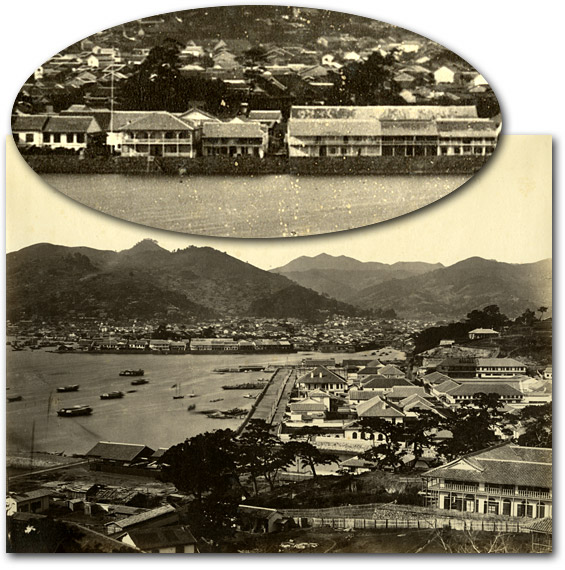 |
  “View of the Harbour, Nagasaki” shows a bustling city of “some 70,000 inhabitants.” The inset enlarges an area on the far shoreline named Dejima, the only location in Japan open to Westerners prior to 1858. This fan-shaped artificial island, isolated from the shore, had been restricted to use primarily by the Dutch. “View of the Harbour, Nagasaki” shows a bustling city of “some 70,000 inhabitants.” The inset enlarges an area on the far shoreline named Dejima, the only location in Japan open to Westerners prior to 1858. This fan-shaped artificial island, isolated from the shore, had been restricted to use primarily by the Dutch.
[bjh47]
|
Western contact with Japan preceded that of the Dutch in the Tokugawa era. Portugal and Spain traded extensively with Japan from the mid-fifteenth to early-seventeenth century. Merchant vessels brought Christian missionaries who proselytized energetically until they aroused the suspicion of samurai authorities. Persecutions ensued and the missionaries were expelled or martyred along with thousands of their Japanese converts. Nagasaki and its vicinity was the site of much anti-Christian violence. One of Beato’s photographs, depicting a small island called Pappenberg, became the symbol of these events and, by extension, the entire Christian experience in Japan.
|
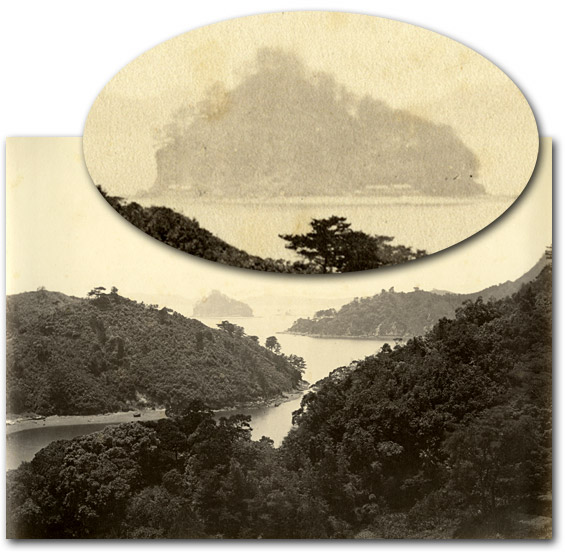 |
  “Pappenberg” is an island near Nagasaki where Christians—both missionaries and their Japanese converts—were thrown to their deaths centuries earlier. “Pappenberg” is an island near Nagasaki where Christians—both missionaries and their Japanese converts—were thrown to their deaths centuries earlier.
[bjh11]
|
It was a particularly popular image once the Treaty of Kanagawa opened Nagasaki to Westerners. The caption vividly describes the persecutions, noting especially the courage of the Japanese Christians.
“PLACED at the entrance to the harbour of Nagasaki, this picturesque little island at once attracts the attention of the new arrival; and its association with scenes of persecution, cruelty, and bloodshed, in the seventeenth century, when numerous Christians were hurled headlong down its precipitous sides, excites both awe and sympathy. To use the words of Sherard Osborn—“If history spoke true, there, by day and night its steep cliffs had rung with the agonized shrieks of strong men, or the wail of women and children, launched to rest, after torture, in the deep waters around the island. If Jesuit records are to be believed, the fortitude and virtue exhibited by their Japanese converts in those sad hours of affliction, have not been excelled in any part of the world, since religion gave another plea to man to destroy his fellow creature.”
|
The photograph of Pappenberg supplied Beato’s customers with an important connection to the history of Westerners in Japan, but it also may have been attractive to another specific segment of his clientele. The opening of the treaty ports in 1859 brought Christian missionaries of several denominations to Japan. The caption suggests that Japan may once again become fertile ground for missionary activity:
“Although there was sweeping persecution of the Roman Catholics, amounting to total extermination at Ximbara [sic], in the seventeenth century, and for over two hundred years communication with the rest of the world was put a stop to—yet there is still reason to believe that a small spark of the Christian religion smoulders secretly among the descendants of the early martyrs.”
|
But while this caption seems encouraging to missionaries, another of Beato’s Nagasaki photographs, View in the Native Town (below), seems to argue caution:
“THIS town was originally the nursery of Christianity in Japan, and owes its rise to the impetuous zeal of a baptized Prince of OMURA, who A. D. 1568 invited the Portuguese Catholic Missionaries to make it their head quarters and built a church there—and with the hot headed intolerance of a new convert was not satisfied with destroying the idols which himself and his forefathers had worshipped, but tried to prohibit old ceremonies and to compel his subjects to adopt the tenets of, to them, a new religion. The fate of thousands of martyrs at Ximabara in 1637, when, in fact, Christianity was virtually exterminated in Japan, was indirectly the consequence of ill judged attempts like this, to force by human means alone, the charitable principles of Christianity on unwilling minds; another undoubted proof, added to the many in our own history, that the sword wins not converts, and that conviction leads men, and thinking men only, to worship the only true God; and that the humble belief in the admirable beauties of Holy writ is more powerful than all the gilded pageantry of royal crusades, or the wordly weight of princely proselytism unassisted by the blessing of Him who rules by love.”
|
|
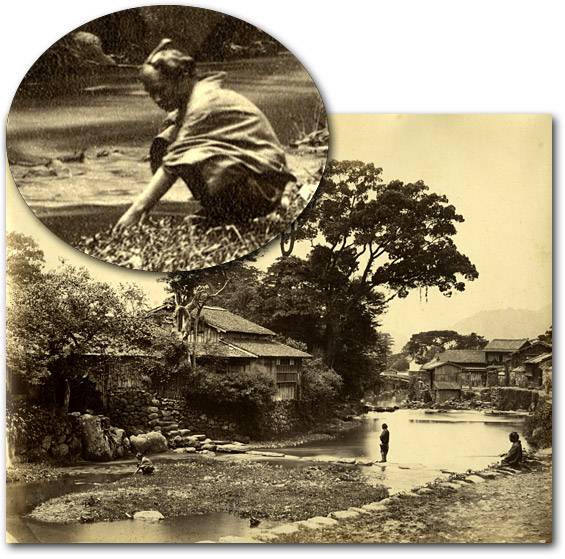 |
  Tranquility abounds in “View in the Native Town—Nagasaki.” Several men are fishing, and the figure isolated in detail sports the traditional male topknot hairstyle. Close scrutiny of the buildings in the background will reveal other inhabitants on the porches and bridge. Tranquility abounds in “View in the Native Town—Nagasaki.” Several men are fishing, and the figure isolated in detail sports the traditional male topknot hairstyle. Close scrutiny of the buildings in the background will reveal other inhabitants on the porches and bridge.
[bjh48]
|
We can be certain that most of Beato’s clientele were, at the very least, nominally Christian. But while missionaries looked to Japan as their next challenge, more than a few anti-Christian polemics appear among the writings of some Westerners who visited Japan. Nagasaki’s history was, in other words, a contentious issue. Captions that spoke on behalf of Beato’s Nagasaki photographs, therefore, needed to communicate with very different constituencies. Or, they need not speak at all. View in the Native Town shows nothing that is inherently Christian. Remove or ignore the caption, and viewers of this photograph (or any photograph, for that matter) were free to interpret it any way they chose.
Many Westerners, especially those who resided in the treaty ports for extended periods, sought to acquire if not appreciation for, than at least informed opinions about indigenous Japanese religious practice and belief. Earnestness on the part of the authors of the captions did not always result in accuracy, however. The caption for Temple Street, Native Town, Nagasaki, for example (below), strives for an informative commentary on Japanese burial practices but mistakenly assumes that the size of burial plots had something to do with the price of land:
“The close proximity of these tombstones is remarkable, and is thus explained. Each person who is buried has to purchase a piece of ground in a cemetery—which becomes the property of himself and descendants—and as a high price is often asked by the priests, the smaller the piece of ground so obtained, the better it suits those of limited means—the custom of burning the dead is said to have originated in consequence of the necessity for purchasing ground for burial—the space occupied by a small earthen vessel containing the bones of and ashes of the dead, being considerably less than that required for a coffin.”
|
|
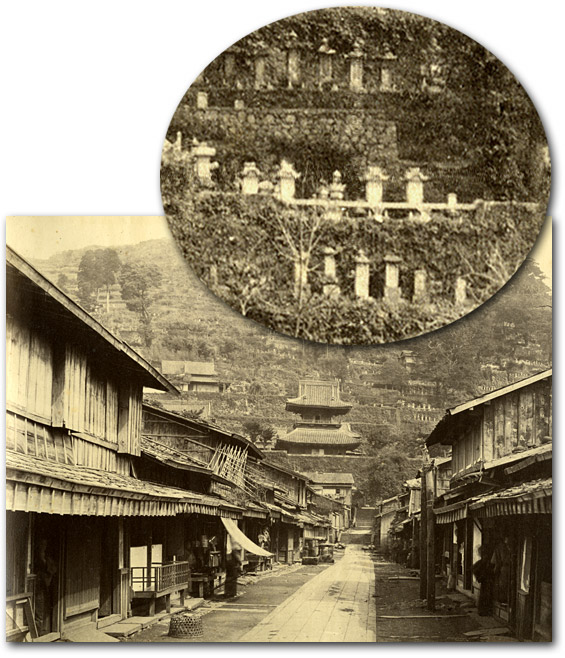 |
  The hillside at the edge of town in “Temple Street, Native Town, Nagasaki” is covered with rows of gravestones in a Buddhist cemetery. The street, according to the caption, was “nearly a mile in length, with a Pave running down the centre, formed of hard stone neatly laid. …” The hillside at the edge of town in “Temple Street, Native Town, Nagasaki” is covered with rows of gravestones in a Buddhist cemetery. The street, according to the caption, was “nearly a mile in length, with a Pave running down the centre, formed of hard stone neatly laid. …”
[bjh10]
|
The caption for a photograph of Mt. Fuji (see image [bjh07]) errs in a similar manner: “The origin of the pilgrimage is traced to the time when Shintoo, the founder of the religion of that name, took up his residence in the mountain.” Apparently, the author assumed that Shinto must have had a founder of the same name. In actuality, the name of this indigenous religion means “way of the kami, or native gods” (as opposed to Butsudo, the way of the Buddhist gods).
The photographs of sacred architecture, Buddhist sculpture, and pilgrimage sites scattered throughout albums like this brought Western viewers into contact with Japanese cultural practice. The authors of the captions strived to make these photographs accessible to an audience that was rarely equipped to grasp the complexities of Japanese religious life. They are often inaccurate, as the examples above illustrate. And many reveal a condescending attitude on the part of the authors (see especially the caption for the Cascade at Jiu-ni-so [bjh 39]). At the same time, however, many of the religious photos in and of themselves capture a serenity and beauty that foreigners clearly found attractive. Beato’s image of the Daionji temple in Nagasaki is one example of this. His stunning rendering of a Buddhist roadside statue far away from Nagasaki, in Hakone, is another.
We can only guess, then, what conclusion each viewer might have drawn from these text-image pairings. Did they come away with an understanding of Buddhist and Shinto beliefs and practices, or just a deepened sense of the mystery and exoticism of Japan?
|
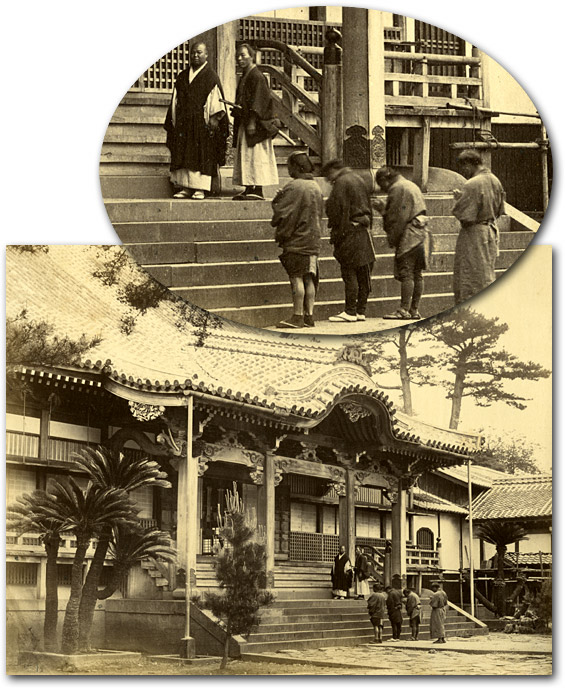 |
  “Temple of Dai-oon-ji—Nagasaki” catches a variety of Japanese clothed as befits their rank and station—a member of the “two-sworded” samurai class, a priest, and several commoners. Foreigners took great interest in religious architecture such as this Buddhist temple, with its fine ornamentation and graceful tiled roof. “Temple of Dai-oon-ji—Nagasaki” catches a variety of Japanese clothed as befits their rank and station—a member of the “two-sworded” samurai class, a priest, and several commoners. Foreigners took great interest in religious architecture such as this Buddhist temple, with its fine ornamentation and graceful tiled roof.
[bjh49]
|
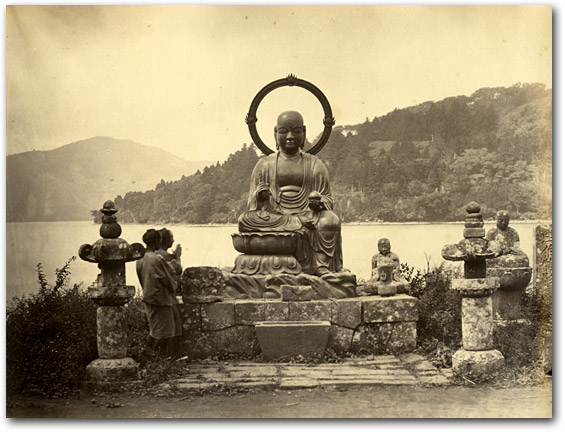 |
  “Bronze Statue of Jeso-Sama—Hakoni Lake” “Bronze Statue of Jeso-Sama—Hakoni Lake”
This is an especially elegant statue of Jizō, a compassionate Buddhist deity revered for aiding travelers and giving guidance to the deceased as they make their journey into the hereafter. Statues of Jizō—large and small, elaborate and plain—were found everywhere in the Japanese countryside.
[bjh14]
|
Conclusion
The Hood Museum album and this unit afford us the opportunity to see a visual culture in the making. As the preeminent commercial photographer working in Japan in the 1860s, Beato was on the cutting edge of an effort to make Japan, its people, and its culture accessible and understandable to the West. His albums represent concerted efforts to organize his project into extended explorations of the places he had access to. While locale and travel sequences provided the primary levels of organization for his albums, the captions cut across these vectors as they explicated the history and culture of individual sites. Each caption imposed specific meanings on its corresponding photograph, but collectively these text-image relationships framed and constructed more comprehensive visualizations of Japanese history and culture, most of which were skewed toward the interests and expectations of 19th-century Western viewers.
This brief introduction to Beato’s scenic views illustrates how we 21st-century viewers can use the century-and-a-half distance we have to develop a critical perspective on Beato’s efforts to visualize Japan. Users are encouraged to peruse the entire album. Look at the photographs, read the captions, and experience the power of images and the potency of text to shape our understanding of a place and its people.
|
|
|

